21st - 26th December, Christmas in Yogyakarta, Central Java.
Total distance travelled: 1123.5km
We arrived in Yogyakarta on the 21st of December - quite a few days before Christmas, but not so far off that it was worth heading off again and finding somewhere else to settle before Santa did his rounds. This grievous situation meant, alas, that we would have to take a whole run of days off in “Jogya” and actually have something of a mini Christmas holiday. We were both concious that the clock was ticking on our visa, and we still had half the island to cross, but after all the hills, bad roads and torrential rain of the last few days we were very happy to have an excuse to put our feet up and take it easy for a while.
Yogykarta turned out to be a very agreeable place to spend Christmas, since it had its own little tourist district that was better equipped than anything we'd come across since leaving Bali. Having cycled through the city – which had a certain relaxed feel as far as Indonesian cities go; it was flat, the buildings low, traffic steady, and had a river winding a lazy course through it – we found the tourist area; a main road with a few subsidiaries littered with hotels, travel agents, restaurants, and bored rickshaw drivers. Java's fairly low level of tourism had been apparent since we'd hopped on the ferry from Bali across the strait; we had probably seen less than twenty tourists since then, but here, suddenly, there were dozens of them. We gazed with wonder as we coasted down the road looking for a place to stay, “My god, Liv” I said, pointing and staring in open awe “Touris!”
There were lots of tourists here, but this is comparatively speaking; we might see five or ten if we walked the length of the road, and about double that number in rickshaw drivers offering transport. So, busy by Javanese standards, quite sedate compared to other tourist hotspots in Asia.
Of course due to it's popularity the prices here were quite steep, but these higher prices and the greater numbers of paying customers meant that they could offer us a standard of living that we had fantasised about over the last month when hauling our bikes around Prigi, or eating condensed milk on bread in Madura. We paid two to three times the amount we would for a room out in the small towns, but the price included hot showers, breakfast, and big cosy beds. There were swimming pools in both our hotels (the festive period was so busy we had to stay at one hotel until Christmas Eve then, recreating the tale of the Nativity, we had to march out onto the cold hostile streets on Christmas Eve seeking shelter... which we had pre-booked and went straight for; an even nicer hotel just up the road), there were English language books on sale in many of the travel agents along the road, there was a massive supermarket just 5 minutes away by foot that sold cheese, chocolate, yoghurt – all kinds of luxuries we had not seen in Indonesia since being here. But all of these pale when held up against the glory of the restaurants. After struggling to find anything more than 2 minute noodles to eat in a lot of places we had been riding through, and putting up with eating and drinking kilogrammes of sugar each day, all of a sudden we had the option of eating fantastic food from around the world. Even the dodgiest translation of a bolognaise was still great, and everything contained a generous dose of vegetables, something that we had been craving on the road since the only way we could get hold of them was through soggy cabbage or a mouses portion of crispy fried onion on the more luxurious 2-minute noodles. Now we could fill ourselves with all kinds of great food that our bodies were crying out for, and thanks to the Tyranny of Christmas we would have to do so for the next five days. It was fantastic.
Other than lie around, read a lot, buy food and eat it we did two things: 1) visited a popular Yogyakartan shopping mall to try to find some presents for each other, 2) Went and saw a ballet performance of the Ramayana.
The shopping mall was an absolutely dreadful experience. Just getting there was a pain in the backside, because after chatting to a rickshaw driver on the way to the shops, we learnt that the mall was half an hour away, and he was offering us an hour's ride on the rickshaw for 10'000INDR. Great! So, once we were ready to go we tracked this same fellow down, only to learn that the 10'000 he had quoted was per person, and for a minimum of 3 hours. So a trip to the mall wouldn't cost 5000 as he'd previously implied, but 60'000. It goes without saying that we left him well alone, and walked for 5 minutes until we found another rickshaw driver who took us there for 10'000. We wondered if any tourists who were drawn in by the original offer of 10'000 for an hour just shrugged and accepted it when the price suddenly rocketed. I mean, I'm all for reeling people in with a good deal, even if the facts are slightly twisted, but when you start immediately clubbing them by doubling the price and placing minimum hour constraints on the deal surely everybody just buggers off and leaves you well alone. Ah well, what did we care, we had a mega mall to explore! Yeah!
This mall was billed as being some terrific must-see place, the biggest mall in the city with all kinds of things to see and do and buy. It certainly looked like it meant business, towering up like a multi-storey cathedral wrapped in adverts, and surrounded with streets clogged with hundreds of market stalls and shoppers. Once we checked these stalls out though it became apparent that they could have made do with only three stalls, because they were basically selling the same three things on loop. T-shirts, wooden carvings, and animal skins with hand painted biblical scenes glued on them. Now, an image of Christ daubed on the patchy-furred skin of an unknown cat sized animal was actually exactly what I wanted for Christmas, but there was no way we could fit it in the panniers so we headed into the glaring phosphorescent lights of the mall, and the consumer nightmare hell that waited inside.
There are many things that we loath about Indonesian shopping malls; firstly the commodities regularly obstruct we, the consumers, from moving around. Random stalls are plonked in the middle of the walkways, along with boxes of stock, and disused children's merry-go-rounds so the hundreds of shoppers get regularly bottlenecked by them. To give a specific example from that afternoon's shop, there was a man sat on a vibrating chair with a picture of an alpine meadow behind him right at the bottom of an escalator and blocking half of the walking space. Bless him, he had his eyes closed, trying earnestly to get his money's worth of relaxation as hundreds of impatient shoppers squeezed around him and bumped into his vibrating feet.
The second thing we hate about Indonesian shopping malls is the lighting. The lighting is so intense that it makes you feel like the building is trying to interrogate you; blazing you with bright white lights that bounce off bright white tiles and the bright white floor. If you told us that snow blindness was common among the patrons of Indonesian shopping malls we would not be at all surprised. It's painful.
But I think the worst thing about the malls, something that sort of undermines the whole operation, is that almost everything for sale is of no value whatsoever. It's all tat. Shop after shop selling the same t-shirts, bulging off the rails and spilling out of the boxes on the floor next to them. Mobile phone accessories designed to make your phone look like something from Dr Moreau's island. Purple rabbit ears you can stick on it, and glittery pouches to pop your recently mutilated rabbit eared phone into, presumably to hide it from public view. Even the expensive watches look cheap since they're put on display in thick plastic cases clogging up half a hallway in front of a fire exit. To be clear, I understand that Indonesia's economy can't support huge electronic goods chains, or outdoor gear retailers that we cyclists might be interested in buying, but it is more than capable of making solid products. Everything in these malls however is built to last 6 weeks, and if it lasts any longer will be out of fashion by then anyway. It has the stench of being a black hole for consumers to chuck their money into, to support the notion of buying and selling commodities for its own sake. You really have to see the Christmas cracker quality of the stuff on sale, all four floors of it, to see what I mean.
If the mall was a soulless void of consumerism sucking the life out of everything around it - which it was – then the epicentre of this abyssal vortex, where everybody's soul is being sucked towards and swallowed up by, is the Barbie college of charm mime stage. The barbie college of charm, as far as we can make out, is a sort of cross between Harry Potter, sexist stereotypes and the seventh level of hell. Barbie and all her friends are off to college, where they don't have to do any work, but just have to charm people by staring doe eyed at men, and smiling sweetly. Bright pink banners, like Nazi propaganda, hung off the seizure-white walls of the mall, toy shops were plastered with barbie's vacant face, and on the ground floor some advertising orcs had constructed a Disney style palace facade stage where young girls got to dress up in horrendously short skirts and mime along to various pop hits, embodying the values of the Barbie school of charm, which was to just stand around looking pretty, but mainly to just buy barbie school of charm products.
And it actually didn't matter if the kids were good at miming or not, because the huge carpeted space in front of the stage, where one would imagine an audience might stand, was filled with shelves of barbie products, leaving no room for anyone but the kids' parents squashed up right at the front. It was so bad that you couldn't actually see the stage from the ground floor; all you could see was the roof of this palace thing and then rows of shelves, lined up like bouncers at a night club and obscuring the view of the kids performing. And as the kids pranced about on the stage they, presumably, were performing to a mute audience; shelves of barbie's staring at them, unmoved, motionless, silent. It was awful, but it did serve as a ripe old visual metaphor for the very worst of modern consumerism, and reminded me of Bill Hick's piece about the devil of modern consumerism making you famous for 10 minutes, at a price...
We failed to find any presents for each other, but we at least escaped alive and relatively unharmed and got back to lying around our hotel and eating good food. In contrast to our ordeal in the mall our trip to the Ramayana ballet on Christmas Eve was bloody brilliant. During the dry season the ballet is performed on an open air stage with a huge Hindu temple from ages past illuminated behind it, probably just about the ultimate in theatre backdrops. Unfortunately during the rainy season they move the show indoors, so Liv and I had a look at the temple then took our seat inside on the night before Christmas to watch the show.
The story was that of the Ramayana, the tale of the kidnap of Sita by a nasty old chap who's name escapes me, and how she is saved by the heroic, and slightly Orlando-Bloom-in-The Lord-of-the-Rings-y, Rama. It's like countless other stories of damsels in distress; from Arthurian romances to Super Mario, except it trumps all of them because it has an army of monkeys in it, and the baddie is finally defeated by the somewhat excessive method of having a mountain dropped on his head. Hindu epics don't concern themselves with being in the least bit believable, and are all the better for it.
That the story is good fun there is no doubt, but the performance itself was what made this an exceptional evening. Every one of the performers was impeccable, and the choreography was always exciting and precisely suited to the characters and scene. Rama moved and fought gracefully, even when he was leaping onto the shoulders of his enemies to deliver a flourish of blows to their bonces, and the baddie strutted about, limbs swaggering this way and that, chuckling like an evil Santa, conceited and delightfully wicked. The monkeys somersaulted and rolled about, while goodies caught arrows mid flight fired from the bows of demons.
Accompanying the performers was an entire musical ensemble, made up of dozens of people playing lots of different traditional musical instruments, including a multitude of kettle drums, large xylophone style instruments, and vocalists singing or adding sound effects when needed. The whole thing came together perfectly, and had us gripped for the whole 90 minutes.
The only criticism we had of it is a criticism of the original text: its dismal portrayal of women. With only one exception the women are there just to kind of mince about like ladies in waiting, and seem fairly incapable of achieving anything without the help of men. The grand finale of the play, and the pinnacle of these crumbly old values, sees Rama spurning Sita because he believes she may have been raped by her captor, and is hence impure and not worth his time after all. To show her purity though Sita hurls herself into a fire, is saved by the fire god, and this act somehow proves her purity, and they all live happily ever after. That can't be a good way to kick off a relationship surely! That's laying the seeds for some pretty heated arguments later on: I'm the selfish one? Remember that time you made me hurl myself into a fire to prove my purity!
I found that the deep flaws in the morality of this ancient tale were quickly forgotten when I recalled the somersaulting monkeys, and as Liv says, it just sort of comes with the territory with old religious texts – of course there will be ideas caught up in them that are incompatible with modern thinking, just as some of our great works of literature, film and theatre will seem to future audiences, and that the Barbie college of charm is now. It's like having an otherwise delightful family member make an offhand racist comment around the table during Christmas dinner. Yes it's really bad, but there's very little point having a go at them, they're old, stuck in the ways, and other than their streak of prejudice they're really nice so you've got to give them a little bit of leeway.
After the ballet, was Christmas day - the laziest day of all. We woke up early and watched the Muppets' Christmas Carol in bed, then we ate, drank and lay around reading for pretty much the whole day. The shopping mall had failed to come up with any prezzies, but thanks to the wonders of modern technology we both got to join our families via skype for their Christmas mornings. Three Christmases away from home reminds one that family is necessary for a proper Christmas, it is, in a way, what the whole thing's about, so it was great to catch up and see them all. We also caught up with Andi Lavahunter, Liv's friend who had given us the details about Ijen crater, and we enjoyed a coffee with him, listening to his plan to head to Ijen the next day because it had recently been upgraded to a level 3 alert status, and Andi Lavahunter likes exploding volcanoes! We did nothing so adventurous as seek out erupting craters, and instead remained tipsy, full of food, with heads buried in our books.
26th December 2011 – From Yogyakarta to Borobudur.
1123.5km – 1170km (approx)
Our bellies were bloated from our food festivities the day before, and our heads were a bit fuzzy from the Guinness and arak as we wheeled our bikes out to the reception on the morning of Boxing day. We really had to get going though. We were about half way across Java, and Jakarta is right at the far top left of the island. Looking at it on the map in the reception it looked like we had a very long way to go – about 650km actually, and it meant that we needed to start covering some kilometres before our visas expired.
We went easy on ourselves this first day back on the road though, making a slight diversion along some flat roads to Borobudur, which lay only about 50km north west of the city. Borobudur is a 9th century Buddhist temple built among the hills of the country surrounding Yogya. It was abandoned many hundreds of years ago; covered by volcanic ash, and then smothered by the jungle. The local tales about the place darkened, and it became known as an unlucky, cursed place; somewhere to be avoided. Skip forward to the latter part of the 1800's, and a British surveyor caught wind of this enormous lost temple in the woods, and had it excavated, and then in the 1980's a lot of money went in to restoring it and it was given the status as a world heritage site, and it really is a beauty.
We had arrived in the little town of Borobudur late in the afternoon on Boxing day, and after being led to a few expensive losmen we backtracked a few hundred metres to a “Youth Hostel”. With it's staff offices and cloak rooms it seemed to be more like a school than a youth hostel, and we think that it was probably actually built to accommodate large school groups visiting the temple, but when we arrived the building was utterly empty but for a handful of staff who showed us the room available. It was, in true youth hostel style, dorm accommodation, but since there was nobody else there we had this large dorm room completely to ourselves, same with the huge shower blocks. It was like we'd stayed behind at school until it was locked up, quiet and empty.
We spent the evening wandering about along the streets of the town in search of a decent meal, but despite our best efforts we ended up with fried chicken and rice. There was one veg option on the menu, but when we asked about it we found out that it was french fries, and they weren't available anyway. We substituted our meal with a bunch of little mandarins from the supermarket, and a carton of fruit and veg juice, and headed back to sleep.
The next morning we walked back into town and towards the main gate of Borobudur. The town has apparently grown around the temple site, and the main entrance is surrounded by losmen and warungs, and busy little roads. From the outside all the gates and carparks and stalls give the place a theme park feel which might very well compromise a site such as this. But once through the gates the temple is buffeted by large lawns and rows of trees, and the bustle of coaches, crowds and souvenir shops going on at the entrance just behind you is kept from view.
The temple is a made from dark stone, and sits on a flat plain with steep hills loping along the horizon behind it. The temple itself hasn't gone in for the dramatic height of the pyramids, or the grandeur of the Taj Mahal, but instead it lies low and wide, sullen and grey; sunk fast into the ground like an enormous bunker.
The steps leading up to the top were positively teeming with people, but the crowds were for the most part avoidable, since many people just went straight up the stairs to the top, missing out on what is, for my money, the best part of the temple. Borobudur is built up in a series of levels, and as you climb each set of steps you can walk off to the left at each of these and circle the temple within a little valley of stone, surrounded on both sides by beautiful and continuous carvings in the rock depicting the life of the Buddha, and the teachings of Buddhism. This story unfolds as you wind your way slowly up each floor, and taken together amounts to an extraordinary amount of detail and craftsmanship that those in the know think must have taken 75 years to complete, a figure that those who research using wikipedia can also quote. In truth, we couldn't follow much of narrative – we weren't actually sure if some bits were depicting the Buddhas life, or the sinful world of material possessions, but it didn't detract from the scale and majesty that the place exuded, even after all these centuries.
We reached the top, and the crowds, and spent about 15 minutes wiggling around large groups of kids, having our photos taken (willingly and unwillingly), and being interviewed by school kids with dictaphones. We always had time for the kids with the dictaphones – we imagined it would be for their school work and therefore a worthy cause – but sometimes we had to bail on them when they asked us for the umpteenth time, after some whispered discussion amongst themselves “Where are you?”, or, equally strangely, “Have you lived in Borobudur all your life?” I kind of felt like answering yes to that one, and imagining what their teacher would have made of it.
We left the crowds, the temple, and the oceans of souvenir shops behind and hit the road again. Since the clock was hanging over us we had decided to forgo previous plans we'd had of venturing down little side roads and following the coast, and were just going to take the highway west the whole way to Jakarta. The road runs straight for about 300km where it then splits to get around a scattering of volcanoes before veering northwards towards the city of Bandung, and finally Jakarta. We had considered just jumping onto the northern highway, which is an even more direct route with no faffing around dodging volcanoes, but during our meeting with Andi Lavahunter two days earlier he had convinced us that the scenery around these volcanoes was worth the few uphill climbs we were committing ourselves too, and there was an active volcano there that was well worth a visit – Mount Papandayan. So, we had two weeks to cycle about 600km, visit a volcano, see in the New Year, get to Jakarta and find a ship to take us to Malaysia. We really had to get going!
Total distance travelled: 1123.5km
We arrived in Yogyakarta on the 21st of December - quite a few days before Christmas, but not so far off that it was worth heading off again and finding somewhere else to settle before Santa did his rounds. This grievous situation meant, alas, that we would have to take a whole run of days off in “Jogya” and actually have something of a mini Christmas holiday. We were both concious that the clock was ticking on our visa, and we still had half the island to cross, but after all the hills, bad roads and torrential rain of the last few days we were very happy to have an excuse to put our feet up and take it easy for a while.
Yogykarta turned out to be a very agreeable place to spend Christmas, since it had its own little tourist district that was better equipped than anything we'd come across since leaving Bali. Having cycled through the city – which had a certain relaxed feel as far as Indonesian cities go; it was flat, the buildings low, traffic steady, and had a river winding a lazy course through it – we found the tourist area; a main road with a few subsidiaries littered with hotels, travel agents, restaurants, and bored rickshaw drivers. Java's fairly low level of tourism had been apparent since we'd hopped on the ferry from Bali across the strait; we had probably seen less than twenty tourists since then, but here, suddenly, there were dozens of them. We gazed with wonder as we coasted down the road looking for a place to stay, “My god, Liv” I said, pointing and staring in open awe “Touris!”
There were lots of tourists here, but this is comparatively speaking; we might see five or ten if we walked the length of the road, and about double that number in rickshaw drivers offering transport. So, busy by Javanese standards, quite sedate compared to other tourist hotspots in Asia.
 |
| Reflexology is popular in tourist hotspots, but its practitioners despise it. |
Other than lie around, read a lot, buy food and eat it we did two things: 1) visited a popular Yogyakartan shopping mall to try to find some presents for each other, 2) Went and saw a ballet performance of the Ramayana.
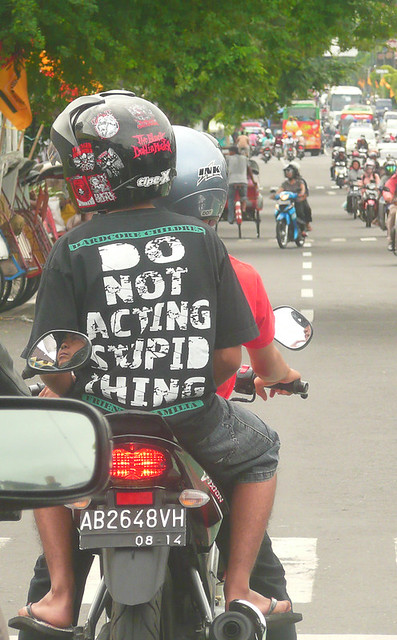 | |||||||||||||||||||||||
| Hardcore children do notacting stupid thing |
This mall was billed as being some terrific must-see place, the biggest mall in the city with all kinds of things to see and do and buy. It certainly looked like it meant business, towering up like a multi-storey cathedral wrapped in adverts, and surrounded with streets clogged with hundreds of market stalls and shoppers. Once we checked these stalls out though it became apparent that they could have made do with only three stalls, because they were basically selling the same three things on loop. T-shirts, wooden carvings, and animal skins with hand painted biblical scenes glued on them. Now, an image of Christ daubed on the patchy-furred skin of an unknown cat sized animal was actually exactly what I wanted for Christmas, but there was no way we could fit it in the panniers so we headed into the glaring phosphorescent lights of the mall, and the consumer nightmare hell that waited inside.
There are many things that we loath about Indonesian shopping malls; firstly the commodities regularly obstruct we, the consumers, from moving around. Random stalls are plonked in the middle of the walkways, along with boxes of stock, and disused children's merry-go-rounds so the hundreds of shoppers get regularly bottlenecked by them. To give a specific example from that afternoon's shop, there was a man sat on a vibrating chair with a picture of an alpine meadow behind him right at the bottom of an escalator and blocking half of the walking space. Bless him, he had his eyes closed, trying earnestly to get his money's worth of relaxation as hundreds of impatient shoppers squeezed around him and bumped into his vibrating feet.
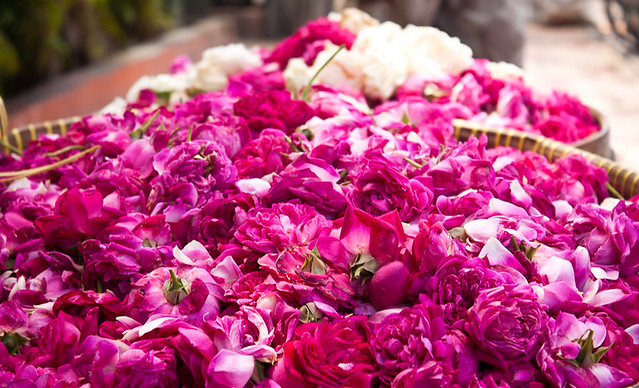 |
| We didn't take any photos inside the mall, I'm afraid, so here is a lovely picture of some flowers that Liv took just down from our hotel. Ahh. |
But I think the worst thing about the malls, something that sort of undermines the whole operation, is that almost everything for sale is of no value whatsoever. It's all tat. Shop after shop selling the same t-shirts, bulging off the rails and spilling out of the boxes on the floor next to them. Mobile phone accessories designed to make your phone look like something from Dr Moreau's island. Purple rabbit ears you can stick on it, and glittery pouches to pop your recently mutilated rabbit eared phone into, presumably to hide it from public view. Even the expensive watches look cheap since they're put on display in thick plastic cases clogging up half a hallway in front of a fire exit. To be clear, I understand that Indonesia's economy can't support huge electronic goods chains, or outdoor gear retailers that we cyclists might be interested in buying, but it is more than capable of making solid products. Everything in these malls however is built to last 6 weeks, and if it lasts any longer will be out of fashion by then anyway. It has the stench of being a black hole for consumers to chuck their money into, to support the notion of buying and selling commodities for its own sake. You really have to see the Christmas cracker quality of the stuff on sale, all four floors of it, to see what I mean.
 | |
| Barbie Princess charm school, Barbie college of charm, same difference. |
And it actually didn't matter if the kids were good at miming or not, because the huge carpeted space in front of the stage, where one would imagine an audience might stand, was filled with shelves of barbie products, leaving no room for anyone but the kids' parents squashed up right at the front. It was so bad that you couldn't actually see the stage from the ground floor; all you could see was the roof of this palace thing and then rows of shelves, lined up like bouncers at a night club and obscuring the view of the kids performing. And as the kids pranced about on the stage they, presumably, were performing to a mute audience; shelves of barbie's staring at them, unmoved, motionless, silent. It was awful, but it did serve as a ripe old visual metaphor for the very worst of modern consumerism, and reminded me of Bill Hick's piece about the devil of modern consumerism making you famous for 10 minutes, at a price...
 |
 |
| During the dry season this is the backdrop to the ballet! |
The story was that of the Ramayana, the tale of the kidnap of Sita by a nasty old chap who's name escapes me, and how she is saved by the heroic, and slightly Orlando-Bloom-in-The Lord-of-the-Rings-y, Rama. It's like countless other stories of damsels in distress; from Arthurian romances to Super Mario, except it trumps all of them because it has an army of monkeys in it, and the baddie is finally defeated by the somewhat excessive method of having a mountain dropped on his head. Hindu epics don't concern themselves with being in the least bit believable, and are all the better for it.
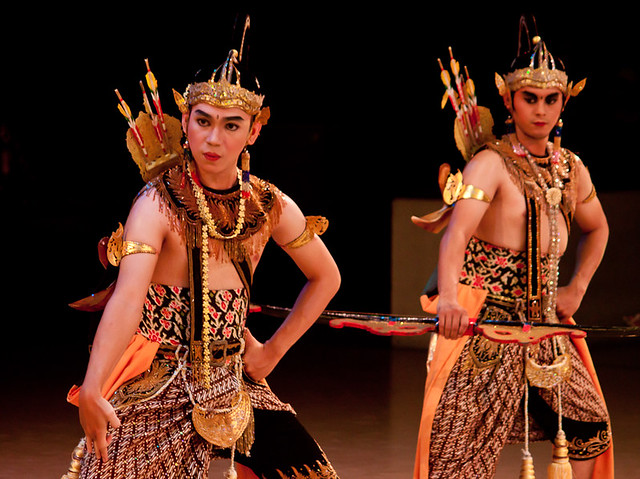 |
| Rama's brother never forgives Rama for showing up wearing the same outfit as him. |
Accompanying the performers was an entire musical ensemble, made up of dozens of people playing lots of different traditional musical instruments, including a multitude of kettle drums, large xylophone style instruments, and vocalists singing or adding sound effects when needed. The whole thing came together perfectly, and had us gripped for the whole 90 minutes.
The only criticism we had of it is a criticism of the original text: its dismal portrayal of women. With only one exception the women are there just to kind of mince about like ladies in waiting, and seem fairly incapable of achieving anything without the help of men. The grand finale of the play, and the pinnacle of these crumbly old values, sees Rama spurning Sita because he believes she may have been raped by her captor, and is hence impure and not worth his time after all. To show her purity though Sita hurls herself into a fire, is saved by the fire god, and this act somehow proves her purity, and they all live happily ever after. That can't be a good way to kick off a relationship surely! That's laying the seeds for some pretty heated arguments later on: I'm the selfish one? Remember that time you made me hurl myself into a fire to prove my purity!
I found that the deep flaws in the morality of this ancient tale were quickly forgotten when I recalled the somersaulting monkeys, and as Liv says, it just sort of comes with the territory with old religious texts – of course there will be ideas caught up in them that are incompatible with modern thinking, just as some of our great works of literature, film and theatre will seem to future audiences, and that the Barbie college of charm is now. It's like having an otherwise delightful family member make an offhand racist comment around the table during Christmas dinner. Yes it's really bad, but there's very little point having a go at them, they're old, stuck in the ways, and other than their streak of prejudice they're really nice so you've got to give them a little bit of leeway.
 |
| Monkey! |
26th December 2011 – From Yogyakarta to Borobudur.
1123.5km – 1170km (approx)
 |
| Farewell Jogya! |
We went easy on ourselves this first day back on the road though, making a slight diversion along some flat roads to Borobudur, which lay only about 50km north west of the city. Borobudur is a 9th century Buddhist temple built among the hills of the country surrounding Yogya. It was abandoned many hundreds of years ago; covered by volcanic ash, and then smothered by the jungle. The local tales about the place darkened, and it became known as an unlucky, cursed place; somewhere to be avoided. Skip forward to the latter part of the 1800's, and a British surveyor caught wind of this enormous lost temple in the woods, and had it excavated, and then in the 1980's a lot of money went in to restoring it and it was given the status as a world heritage site, and it really is a beauty.
We had arrived in the little town of Borobudur late in the afternoon on Boxing day, and after being led to a few expensive losmen we backtracked a few hundred metres to a “Youth Hostel”. With it's staff offices and cloak rooms it seemed to be more like a school than a youth hostel, and we think that it was probably actually built to accommodate large school groups visiting the temple, but when we arrived the building was utterly empty but for a handful of staff who showed us the room available. It was, in true youth hostel style, dorm accommodation, but since there was nobody else there we had this large dorm room completely to ourselves, same with the huge shower blocks. It was like we'd stayed behind at school until it was locked up, quiet and empty.
We spent the evening wandering about along the streets of the town in search of a decent meal, but despite our best efforts we ended up with fried chicken and rice. There was one veg option on the menu, but when we asked about it we found out that it was french fries, and they weren't available anyway. We substituted our meal with a bunch of little mandarins from the supermarket, and a carton of fruit and veg juice, and headed back to sleep.
The next morning we walked back into town and towards the main gate of Borobudur. The town has apparently grown around the temple site, and the main entrance is surrounded by losmen and warungs, and busy little roads. From the outside all the gates and carparks and stalls give the place a theme park feel which might very well compromise a site such as this. But once through the gates the temple is buffeted by large lawns and rows of trees, and the bustle of coaches, crowds and souvenir shops going on at the entrance just behind you is kept from view.
The temple is a made from dark stone, and sits on a flat plain with steep hills loping along the horizon behind it. The temple itself hasn't gone in for the dramatic height of the pyramids, or the grandeur of the Taj Mahal, but instead it lies low and wide, sullen and grey; sunk fast into the ground like an enormous bunker.
The steps leading up to the top were positively teeming with people, but the crowds were for the most part avoidable, since many people just went straight up the stairs to the top, missing out on what is, for my money, the best part of the temple. Borobudur is built up in a series of levels, and as you climb each set of steps you can walk off to the left at each of these and circle the temple within a little valley of stone, surrounded on both sides by beautiful and continuous carvings in the rock depicting the life of the Buddha, and the teachings of Buddhism. This story unfolds as you wind your way slowly up each floor, and taken together amounts to an extraordinary amount of detail and craftsmanship that those in the know think must have taken 75 years to complete, a figure that those who research using wikipedia can also quote. In truth, we couldn't follow much of narrative – we weren't actually sure if some bits were depicting the Buddhas life, or the sinful world of material possessions, but it didn't detract from the scale and majesty that the place exuded, even after all these centuries.
We reached the top, and the crowds, and spent about 15 minutes wiggling around large groups of kids, having our photos taken (willingly and unwillingly), and being interviewed by school kids with dictaphones. We always had time for the kids with the dictaphones – we imagined it would be for their school work and therefore a worthy cause – but sometimes we had to bail on them when they asked us for the umpteenth time, after some whispered discussion amongst themselves “Where are you?”, or, equally strangely, “Have you lived in Borobudur all your life?” I kind of felt like answering yes to that one, and imagining what their teacher would have made of it.
We left the crowds, the temple, and the oceans of souvenir shops behind and hit the road again. Since the clock was hanging over us we had decided to forgo previous plans we'd had of venturing down little side roads and following the coast, and were just going to take the highway west the whole way to Jakarta. The road runs straight for about 300km where it then splits to get around a scattering of volcanoes before veering northwards towards the city of Bandung, and finally Jakarta. We had considered just jumping onto the northern highway, which is an even more direct route with no faffing around dodging volcanoes, but during our meeting with Andi Lavahunter two days earlier he had convinced us that the scenery around these volcanoes was worth the few uphill climbs we were committing ourselves too, and there was an active volcano there that was well worth a visit – Mount Papandayan. So, we had two weeks to cycle about 600km, visit a volcano, see in the New Year, get to Jakarta and find a ship to take us to Malaysia. We really had to get going!
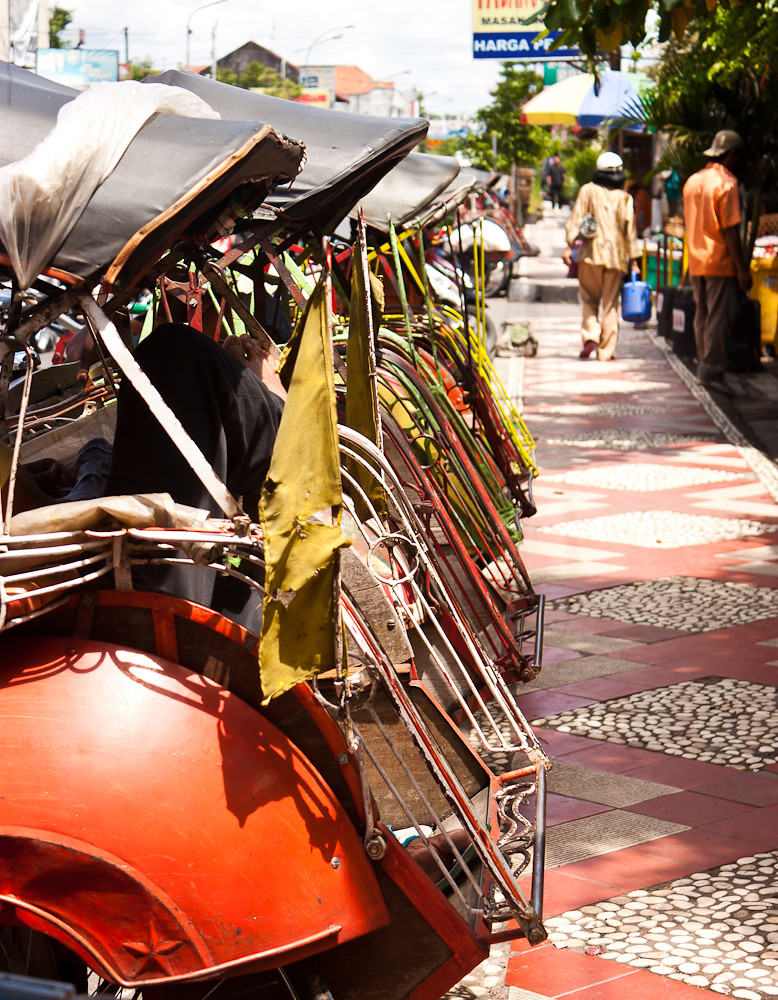
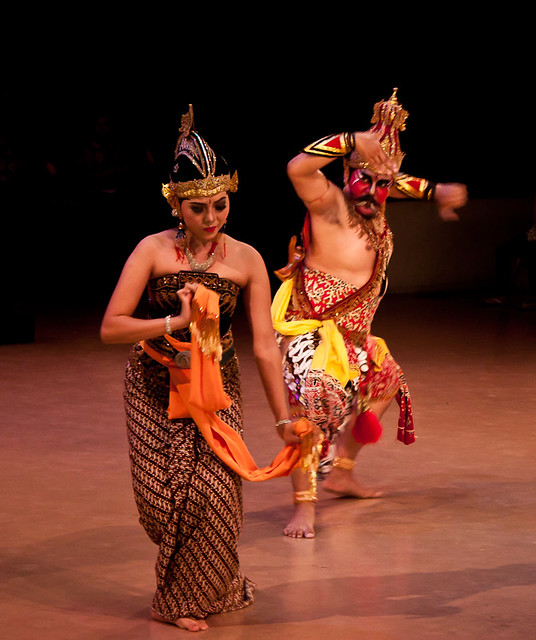
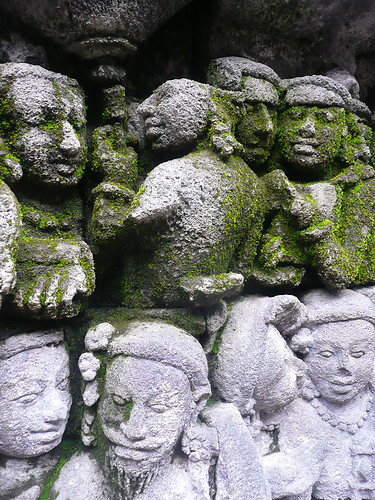


Hi Liv and friend!
ReplyDeleteThis looks an amazing trip. Liv, as you know, I pretty much detested Indonesia so it's been hard but hilarious reading about your exploits! You look great, Liv. This is the first time I've caught up with you so will be following from now on. I am still in Sardinia - I'd like to say having an easier time than you but its never the case is it? I'm having a fabulous time even if the locals are unfathomable and the bureaucracy hilarious. Post Offices in deepest Indonesia would be more efficient but not have such good artwork. Happy travels. I am envious even while you're in Indonesia.... when you get to the next bits, you might inspire me to get on a bike. Actually I am running a lot at the moment so you never know maybe I'll run to Australia next time. x
Message was from Amanda Saunders - I don't know why my picture didn't come up. x
DeleteThanks Amanda! Glad you're enjoying the blog, it is an adventure. Certainly not all downhill and easy. Am about to check out your friends cycle blog -maybe get some tips. Glad you're enjoying Sardinia or even if its hard going I'm sure you will always find something to laugh about. Don't run to Australia run and meet us, we'll cycle half the way so it'll probably be easy. Where's your picture? xx
Delete